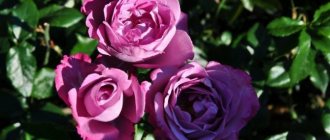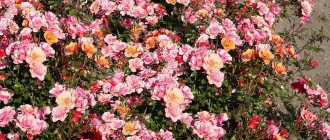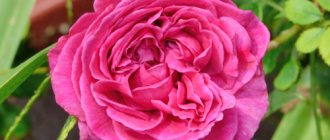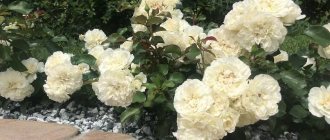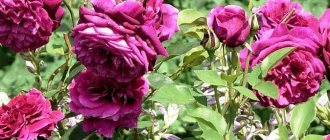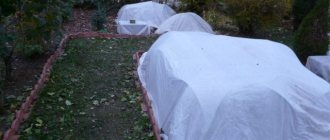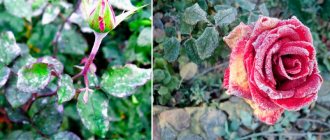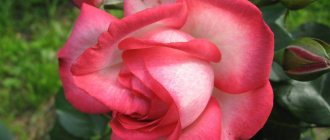I’ll tell you about the secrets of growing one of the most beautiful varieties of floribunda. Rose Blue Fo Yu was registered quite recently, in 2007, in England. The author of the variety is the well-known breeder Peter James. Despite such a young age for the variety, the flower has managed to gain enormous popularity among flower growers in different countries. The plant amazes with the unusual color of its petals and its delicate, refined aroma, but first things first.
Brief description, characteristics
Blue Fo Yu has crimson or white bases of the inflorescence petals, the top of the petals is lilac-blue, the middle of the flower is white, the stamens are golden-yellow. Thanks to the combination of these colors, the color of the bud appears blue. The color shade may vary depending on external factors (lighting, weather, planting location, composition and type of soil).
Rose Blue Fo Yu
The height of the compact branched bush is 60-200 cm; width – up to 120 cm; the diameter of conical or flat-cupped buds distributed evenly throughout the bush is 4-9 cm; the number of petals per bud is 9-20, green semi-glossy leaves are medium in size. Shoots with sharp thorns are directed vertically. Rose flowers are grouped into clusters, each with 3 to 7 buds. There are Blue Fo Yu stamps.
Features of the variety
Characteristics of popular varieties
The most common varieties of spray roses include:
- Rose Tamango is formed by a compact bush, the height of which is no more than 60 cm. It reaches half a meter in diameter. The distinctive features of the variety are lush, long-lasting flowering and compactness. Velvet flowers of a dark crimson color are formed on the bush, which reach 7 cm in diameter. The flowers consist of a large number of petals. Each branch usually contains up to 10 buds. The variety is resistant to diseases and low temperatures. It can grow both in sunny areas and in partial shade. Often used to decorate personal plots.
- Rose Droplet is red, pink, purple and white - Spray rose, the height of which does not exceed 40 cm. Delicate Droplet is a border flower, which is often planted along paths to decorate them. In addition, such flowers can be grown at home.
- Rose Typhoon mini has a significant feature - abundant and long flowering until the first frost. The inflorescences are densely double, bright orange. The diameter of the flower can reach 5 cm. The height is no more than 0.7 m, so the variety cannot definitely be called a climbing variety. Up to 10 buds can form on each shoot. The variety is resistant to low temperatures and diseases.
- Rose Orion is one of the most delicate representatives of this species, which blooms with large flowers of a soft lilac color. The flowering is not only lush, but also long-lasting. A significant advantage of the variety is its excellent cold resistance.
- Cherie Cheops spray is a rose whose bushes reach 0.75 m. The diameter of the inflorescences is no more than 5 cm, the color can be white, ivory with a greenish tint. There is practically no smell. The plant blooms continuously, starting from the second or third decade of May and ending in late autumn. Like most representatives of this group, the variety has good cold resistance and disease resistance.
- The Antigua rose can reach 0.7 m in height. The flowers are miniature, their diameter does not exceed 5 cm, they emit practically no aroma, and the color is pink-orange. Flowering lasts almost the entire growing season. Characteristic features of the species are increased resistance to low temperatures and diseases.
- Beach Hilkado is a spray rose that was recently bred by breeders from the Netherlands. The height of the plant, as a rule, does not exceed 70 cm. Each shoot has approximately 15 buds, their color is deep pink. The diameter of each flower is no more than 5 cm, the aroma is noticeable, but not intense. The flowering is lush and lasts almost the entire growing season.
- Fire Flash is a fairly common variety in this group. The height of an adult bush reaches 0.7 m. The color of the flowers is unusual: the buds are two-colored and variegated. The colors are mainly yellow and red and do not fade when exposed to direct sunlight. Flowering is long-lasting, but only if all the rules of agricultural technology are observed. The variety is resistant to low temperatures and diseases. It is often planted for decorative purposes in garden plots in central Russia.
Fire flash
Use in landscape design
When is the best time to plant roses in open ground?
Thanks to its advantages, the Blue For Yu rose has gained great popularity among flower growers. With proper care, rose bushes look symmetrical and elegant; the plant will become a real decoration of the garden.
Both borders, flower beds and small rose gardens, as well as containers and large pots, are suitable for growing. The plant is quite tall, so it can be used as a hedge. Pairs well with lavender and Liola, Rhapsody in blue, Amazing Grace and Queen of Sweden roses.
Growing in a pot
Organization of wintering
The frost resistance indicators of the Blue Four Yu variety are considered average (up to -20 degrees).
Initially, the rose should be planted in a place protected from the wind, and after autumn pruning it must be covered. The bush is completely covered with peat or river sand.
If weather forecasters predict a harsh winter, the tubercle is covered with spruce branches or spandbond.
Growing a flower, how to plant it correctly in open ground
Rose Chippendale - characteristics of the varietal shrub
There are some requirements for planting in open ground.
In what form is planting carried out?
Growing many hybrid roses from seeds and cuttings is a difficult and expensive task. It is better to purchase high-quality seedlings from a botanical garden or nursery.
Two types of seedlings are sold for planting:
- with open roots: the root system is treated with hydrogel to protect it from drying out. Seedlings take a long time to take root; most often the rose produces its first flowers only in the second year after planting;
- Closed-root: Ideal for first-time rose breeders, although they are more expensive than bare-rooted plants. The roots are in a special soil, from which the necessary nutrients are constantly obtained. The rose blooms in the first year.
What time does boarding take place?
Planting of seedlings should be done in well-warmed soil. The best time for this process is spring, but you can plant a rose in early autumn.
Selecting a location
Partial shade is the best place to plant Blue Fo Yu; lack of light or direct sunlight can harm the plant. You should not choose places near groundwater and blown by the wind.
About blue rose: description and characteristics of varieties, agricultural cultivation techniques
In 1855, the first attempts were made to produce blue roses. Breeders have managed to develop several species with blue petals. And sometimes they acquired blue shades if they were grown in certain conditions. Much later, in 1909, the Veichelblau variety was obtained, and in 1974 two more appeared - Charles de Gaulle and Blue Moon. Unfortunately, they only had lilac and purple tones, which only from a distance resembled blue. Only in 1978 was the Blue Parfum variety created, and a little later in 1984 the German Blue river variety appeared. Finally, the flowers began to look like real blue roses. And in 2009, Japanese scientists were able to develop flowers with bright blue petals.
Now in the world there are a large number of varieties called blue roses. The flowers have different shades: purple, lilac, lavender, burgundy. Only for a certain period of time do their petals turn blue. The most famous types are listed here:
- Rose Plantin un Bloemen;
- rose Blue Magenta;
- Rose Blue Eden;
- Rose Blue Bell;
- rose Blue Wonder;
- Rose Bluebell;
- Rose Bluebird;
- Rose Blumen;
- rose Blue for you;
- rose Mami blue;
- rose Midnight rose;
- rose Pacific Blue;
- Blue Cuff rose;
- Blueberry Hill rose;
- Blue girl rose;
- rose Blue boy;
- Rose Blue Queen;
- rose Blue parfum;
- rose Wild blue yonder.
Now in more detail about some varieties from the Blue rose group.
How to prepare the soil and flower for planting
Loamy soil with humus and good artificial or natural drainage is the best soil for planting this unusual beauty.
Before planting, the root system of the rose must be shortened by 30 cm and placed in a growth-regulating composition.
Step by step landing procedure:
- Dig planting holes approximately 60 cm deep and 50 cm wide, the distance between neighboring plants is 1 meter;
- Fill the holes halfway with prepared soil, place drainage at the bottom;
- Enrich the top layer of soil from the garden with mineral fertilizers, ash, humus, leaf soil, sand and chalk. Then fill the hole with the resulting composition.
Landing
Plant care
The main points in caring for the Blue Fo Yu rose are weed control, mulching and loosening the soil.
Watering rules and humidity
The flower needs to be watered once a week; one adult plant needs about 10 liters of water. In hot weather, it is recommended to increase the amount of watering.
Fertilizing and soil quality
During the flowering period, the Blue Fo Yu rose is fertilized with special nitrogen compounds. In August, it is advisable to introduce potassium-nitrogen mixtures.
Important! These rules do not apply to flowers in the first year of planting.
Trimming
In spring and late autumn, rose bushes need to be pruned, especially weak shoots to promote future growth.
Weak shoots need more intensive pruning. You should not shorten the shoots too much in the spring - this will slow down the onset of flowering. Before wintering, the plant can be pruned more radically. After the procedure, the bush should reach only 30-40 cm in height.
All buds and immature reddish shoots are removed from the plant. They also carry out sanitary pruning, removing damaged and dry fragments. In the spring, attention is paid to formative and repeated sanitary procedures. In summer, faded buds are removed from the plant - this promotes longer flowering.
Trimming
Features of wintering a flower
Blue Fo Yu roses can withstand frosts down to -20 degrees.
In the fall, after pruning, the plant must be covered: completely covered with sand or peat. If a harsh winter is coming, it is advisable to cover the top of the tubercle with spruce branches.
Basic rules for growing blue roses
Rose Renaissance
Important! You cannot arrange a rose garden in lowlands, or where there is close groundwater. They do not like stagnant water or wetlands
Their roots may rot.
They usually choose well-lit places. It is best for the sun to shine actively in the morning. The eastern or southeastern side of the site is suitable. The flower garden must be reliably protected from winds and drafts.
Blue roses prefer light, fertile, humus-rich, breathable, loose, neutral, slightly acidic soils (loams). If the soil is heavy, sand, compost, and ash are added.
Flowers are planted at a distance of 1 m from bushes, to large trees - 2 meters. Can be grown in a greenhouse.
Dig a hole for planting a plant 2-3 times larger than the roots of the bush. Drainage is poured at the bottom, fertilizers are added, filling the pit halfway, then garden soil.
Pre-soak the roots (for 2-3 hours) in a growth stimulator (Kornevin, Heteroauskin). A seedling is planted, sprinkled with earth, compacted, and moistened with warm water.
Care
Water roses regularly, abundantly (1-2 times/week). In hot, dry weather almost every day. Watering is carried out in the evening after sunset. Use settled water.
In the first year, plants do not need fertilizing. The following spring, nitrogen fertilizers are applied twice, taking a break of 14 days. You can use the following composition for 1 liter of water:
- saltpeter (2 g);
- urea (1 g).
Feed with potassium-phosphorus substances during the formation of buds. During flowering, fertilizers containing magnesium, sulfur, potassium, and phosphorus are used.
In autumn, nitrogen, potassium, and phosphorus fertilizers are applied twice. You can alternate mineral mixtures with organic substances. They use liquid mullein, chicken droppings, and ash.
Systematically weed the plants, loosen the soil around the trunks, mulch with peat and dry manure.
In the spring, formative (4-6 buds are left), sanitary pruning is carried out. In summer, faded buds, dry leaves, and overly elongated branches are removed. In the fall, sick, weak, damaged, thin shoots are pruned. Shorten branches before winter.
Important! Cut off the first buds on young seedlings so that the roots develop better
Diseases, pests
Usually blue roses have good immunity. In spring and autumn, preventive treatment is carried out with known fungicides.
Note! You can plant marigolds, tansy, mint, and garlic next to them. They will protect plants from insects
In hot or damp weather, plants can be affected by various diseases or attacked by insect pests.
- Powdery mildew. Use Fundazol, Strobi, Ridomil-Gold.
- Rust. Treated with Fitosporin, Fundazol, Tilt.
- Rust. Treated with Fitosporin, Fundazol, Tilt.
- Gray rot. Use Euparen, Fundazol
- Aphid. You can use a soap solution and add alcohol to it. In advanced cases, insecticides are used (Iskra, Alatar, Actellik).
- Gray rot. Use Euparen, Fundazol
- Sawfly. Spray with Karbofos.
- Spider mite. They use Aktar, Alatar, Inta-vir.
Preparing for winter
In autumn, reduce watering. Cover the foundations with earth and peat. Bend roses to the ground. To prevent the plants from rotting, lay dry boards or spruce branches. Cover with dry leaves and rotted humus. Cover with spruce branches. A frame is built over them. Wrap it in agrofibre and stretch polyethylene on top.
Rose blossom
Rose Blue Fo Yu blooms with unusual double flowers and emits a unique fruity aroma.
Period of activity and rest
The flowering period of Blue Fo Yu lasts from June to October. The rose blooms in two (sometimes more) long waves, each time a large number of buds bloom. The rest of the time the rose rests.
Care during and after flowering
During the flowering period, it is necessary to remove faded buds from the flower, do not forget about watering and loosening the soil.
What to do if it doesn’t bloom, possible reasons
Important! There is no need to worry if the Blue Fo Yu rose does not bloom in the first year of planting.
If this happens next year, you need to find out the reasons, which may lie both in the quality of the seedling and in the actions of the gardener himself. Much depends on the landing site. In the absence of space, in the shade, near groundwater and in poor soil, the plant most likely will not bloom. It is also necessary to pay attention to the rose’s neighbors, who can take away the necessary nutrients. Improper care and pruning, pests and infections also affect flowering.
Pros and cons of the Blue for you rose
The exquisite color of the petals, the unique aroma, the duration and abundance of flowering are the undeniable advantages of the English variety. The disadvantages of a European beauty include:
- The flower does not tolerate heavy rainfall; during the rainy season, it drops buds and flowers, and the petals fly to the ground.
- The exquisite color of the petals may fade if the growing conditions are not met.
- Requires shelter for the winter.
- Needs additional mineral supplements.
In general, it is not difficult to grow Blue Fox on a plot; it is important to choose the right place for the English bush and carry out preventive treatment of plants against insect pests.
Flower propagation
Blue Fo Yu, like most floribunda roses, is propagated using cuttings.
When is it produced?
Roses of the Blue Fo Yu variety are particularly sensitive to air space, light and heat. Therefore, it is best to plant cuttings in the spring in a pre-prepared place with good lighting and protected from the winds.
Detailed description
From a shoot that has already become lignified, branches about 8 cm long are cut above the bud. The upper cut is straight, the lower is oblique. After this, the cutting is placed with the lower cut to the middle in the prepared planting groove. The distance between the grooves should be 15-30 cm. After planting, the plant is covered with polyethylene. Proper care of cuttings consists of loosening the soil, airing, fertilizing, watering and covering for the winter. When buds appear, they must be removed urgently, otherwise the root system may develop incorrectly, which will lead to negative consequences in the future.
Important! The cuttings take 2 years to strengthen in the ground; in the third year they can be planted in a prominent place as a garden decoration.
Growing and care
One of the undoubted advantages of hybrid tea varieties is their comparative ease of care. This also applies to the Blue Perfume rose. But there are still important nuances of agricultural technology:
- Watering. In the first season after planting and during budding - every 2-3 days. In other cases - about once a week (taking into account precipitation), allowing the substrate to dry 4-5 cm deep. Rose Blue Perfume is watered exclusively at the root. Use soft, non-cold water.
- Fertilizer application. Feeding is carried out 4 times per season. At the beginning of the active growing season, organic matter (humus, compost) is added to the soil to maintain soil fertility and nitrogen fertilizers necessary for growing green mass. During the formation of buds and after the end of the first wave of flowering, Blue Perfume uses complex fertilizers for roses. At the end of September, the bush needs phosphorus and potassium (one-component, special “autumn” fertilizers or wood ash).
- Trimming. Rose Blue Perfume does not need forced formation. But it needs sanitary cleaning. Before active sap flow begins in the spring, they get rid of frozen shoots that have broken under the weight of snow. In the fall, when the plant “goes into hibernation,” faded buds and dried stems damaged by diseases and pests are cut off.
- Preparing for winter. The construction of a special shelter for the Blue Perfume rose is only necessary if the temperature is predicted to be below -25 ºС. Otherwise, you can limit yourself to adding humus to the base of the bush (form a mound 15-20 cm high). In more severe conditions, the tree trunk circle is covered with the same humus, peat or compost (layer 10-12 cm), spruce branches or fallen leaves are thrown on top. The branches of the bush are tied, a special cover is put on it, a cardboard box, a wooden box (the dimensions of the Blue Perfume rose allow this) or wrapped with breathable material in 2-3 layers.
From the moment of planting, it is better to water Rose Blue Perfume by hand and at the root in order to “get used” to this method
Important! A very useful agrotechnical measure is mulching. In such a flower bed, weeds almost do not grow, the soil does not “cake” into a dense crust, you can water the rose less often - water from the soil does not evaporate so quickly
Diseases, pests and ways to combat them
Rose Blue For You resists many infections well. For prevention, you can use water sprays with the addition of copper sulfate or Bordeaux mixture. Possible flower diseases:
- black spot – black spots appear on the leaves, the lower leaves turn yellow and fall off. Reasons: high air humidity and sudden temperature changes. Prevention: spraying with chemicals (Profit, Skor, Topaz, Fitosporin), a weak solution of mullein, nettle infusion or horsetail decoction. Remedies: Removal and destruction of infected leaves;
- rust - bright orange tubercles on shoots and leaves, which subsequently darken and their number increases. Reasons: increased air humidity. Prevention: the same as for black spotting. Methods of elimination: removing and burning infected bushes;
- powdery mildew - the appearance of powdery plaque on shoots, leaves and buds. Reasons: lack of lighting, too dense plantings and (or) excess nitrogen in the soil. Methods of elimination: remove infected plant fragments, then spray with mullein infusion or water, followed by application of wood ash, after two hours, rinse the plant.
The main pests of Blue Fo Yu:
- bronze beetles are large, bright green-golden beetles that feed on petals, pistils and stamens. Control: collect and destroy pests early in the morning;
- The roseate sawfly is a black-brown, bee-like insect that destroys stems, buds and flowers. Control: cutting and burning damaged plant fragments;
- Green rose aphids are small insects that attack roses in numerous colonies. They settle on leaves, peduncles, buds and shoots. As a result of damage, the shoots become bent, the leaves curl, and the buds do not open. Fight: spraying with a weak soap solution with the addition of a decoction of wormwood, infusions of tomato tops, garlic, yarrow, hot pepper or tobacco. If these measures do not help, you need to treat with insecticides: Aktary, Aktellika, Antio, Inta-Vira, Fitoverma, Fufanona
Important! Floribunda rose Blue Fo Yu is loved by both experienced gardeners and beginners. It adapts well to different climate conditions. Despite its unpretentiousness, the plant pleases with long and lush unusual blue flowering. The rose is beautiful both alone and in a group with other plants. This beauty is a real decoration of the garden.
Features of the rose Ice fo Yu (Ayz fo Yu, Blue fo Yu)
There are not so many roses with even closely similar colors, so Ice Fo Yu will surely appeal to all lovers of unusual varieties. The small number of petals in each flower in this case is rather a huge advantage of the variety - in a more double flower it would not be possible to see the enchanting combination of pure white edges of the petals and first light purple, and then more saturated centers. The picture is completed by bright yellow, almost orange stamens, which create a very contrasting combination with the white and purple tones of the petals. Interestingly, the unopened buds of the Aiz fo Yu rose have a yellowish tint, which persists for some time on the back of the petals.
This floribunda has fairly compact inflorescences, including up to 10 buds. When they fully bloom, you get a very compact and cute bouquet, consisting of just one shoot. When flowering ends, the petals fly off on their own, leaving behind only the seed pod, which does not spoil the appearance of the bush. In addition, roses are not afraid of either prolonged rains or heat - the flowers are not damaged by precipitation, do not melt or fade in the sun. Interestingly, the white petals of Eyes for You can turn slightly pink when the temperature drops, and a long absence of sun leads to the fact that the flowers open only halfway, hiding the yellow stamens behind the inner row of petals, but maintaining the “signature” color transition from white to rich -purple.
Rose Ice for You was obtained in 2008 thanks to the efforts of the English breeder Peter J. James. Other names of the variety are Blue Eyes, PEJbigeye, Pejambigeye.
Interestingly, this rose is a hybrid of Hulthemia persica - Persian (Iranian) Gulthemia, which, in fact, is not a rose, but is considered a distant relative of the rose hip. We classify it as a floribunda, but this is not entirely correct, since the number of popular varieties of such hybrids is growing every year, and they deserve a separate section. However, most Gulthemia hybrids have a contrasting eye in the center and thanks to it, it is quite easy to distinguish this group of varieties. From Gulthemia, the rose inherited resistance to hot climates (the northernmost areas of growth of the original plant are Kazakhstan and Southern Siberia), as well as extraordinary resistance to precipitation.
The first hybrids were obtained back in 1975, but were characterized by low resistance to fungal diseases (powdery mildew in particular), but modern varieties, including Ice Fo Yu, practically do not notice diseases traditional for roses.
